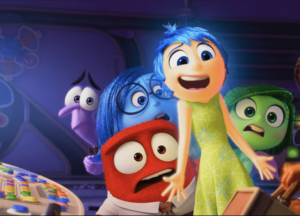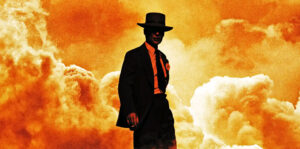Everyone knows the famous exchange in The Wild One (1953) even if they haven’t seen the movie — a brassy dame in a blonde beehive asking Marlon Brando “What are you rebelling against?”, a slightly pouty-looking Marlon Brando answering, “Whattaya got?” Most people probably don’t remember the grace note in this exchange, which is the brassy blonde cackling wonderfully at Brando’s answer.
I like to imagine a similar exchange being inserted into David Fincher’s 1999 film Fight Club, with the same brassy blonde asking the question, but instead of Marlon Brando giving the answer, it’s Fight Club’s Edward Norton. “What are you fightin’ against?” the blonde would ask, and Edward Norton, looking even poutier than Marlon Brando but also sleepy and a little bruised around the eyes, would answer, “Well, a lot of things. For example….” Then, in his sad nasal voice, he’d start to list all the ways the imperfect world has wounded him and let him down and left him unfulfilled. On the beat where the blonde’s brilliant laugh is supposed to erupt there is no laugh because there is no beat, because Ed Norton is still listing his complaints. Then the movie cuts to where the blonde was standing but she’s not there, and so the camera whirls to the bar where, without waiting for Ed Norton to finish his list of complaints, she’s gone to get another beer.
In The Wild One, Marlon Brando’s Johnny is making a short declaration about himself — he’s rebelling because he’s rebellious. But in Fight Club, Ed Norton’s talkative “Narrator” is looking outward. He has a critique, of society. This distinction is pleasingly, neatly periodising. Brando’s famous response — hinting at violence and upheaval that he disdains to justify — is redolent of the early Fifties, when Sartre-style existentialism would have been circulating among the sort of people who wrote movies. On the other hand, the answer I’ve imagined Ed Norton’s Narrator giving in my extra Fight Club scene — which he does give throughout the actual Fight Club, and gives even more fully in the Chuck Palahniuk novel the movie’s based on — is so Nineties.
This year, Fight Club is celebrating 25 years as a box office disappointment that became a cult obsession for teenage boy and young men. That it came out at the very end of the Nineties is almost too convenient, making it not only a faithful document but also a consummation or climax of that decade.
But I should start at the beginning, at the moment where our unnamed “Narrator” is battling a small handful of afflictions, both physical and spiritual, that seem to stem from his crushing insomnia, or that might be the reason he can’t sleep in the first place. It’s not clear. Mainly, he’s listless and disaffected at his white-collar job, which requires a fair amount of airplane travel. And he’s feeling cynical about the many material comforts this well-paying job has allowed him to assemble, instead of comforted by them. Other issues are probably festering below the surface, but these are the ones we know about when the Narrator visits a young doctor who, instead of handing him a prescription for sleeping pills, suggests he check out a support group for men whose cancerous testicles have been removed.
The Narrator finds this suggestion befuddling, understandably, but he decides to give it a shot, and he’s pleasantly surprised when it works. After sitting in the testicular cancer group, and other support groups for people with real afflictions, the Narrator’s insomnia dissipates completely. He’s finally able to sleep — until a raggedy beauty named Marla Singer (Helena Bonham-Carter) starts showing up to his groups. She’s obviously a “tourist” like him, not a true sufferer, and her presence in the groups destroys their healing powers for him. After a brief, sweet spell of sleeping like a baby he’s thrown into a new insomnia, this time with added bitterness at Marla Singer.
It’s in this bitter and bleary state, on an airplane during another work trip, that he meets the heedless and charismatic hipster who made this film into a cult object, the movie demigod whose name has echoed through one generation already and will surely echo into a next: Tyler Durden, played indelibly by Brad Pitt. On the night they meet, after they’ve been drinking in a bar, the Narrator and Tyler start fighting in the parking lot, more or less out of curiosity. Neither man has been in a fight before. When, on subsequent nights, they repeat these outdoor recreational fistfights, men start gathering to watch, and then some, and then a lot, of these men pair off to fight as well. The Narrator and Tyler thus expose two powerful forces working, hidden, among the sizeable population of men like them: a desire to fight, and a desire to join a club. Or, to put it less glibly, they discover that men like them carry a desperate hunger to learn something true and essential about themselves outside of their numbing and boring lives, even if this entails pain, injury and disfigurement; and they learn that, for these men, the best way to start on this path of discovery is in the company of other men.
This message isn’t new, of course. For example, young men terrified at being shipped off to war have often missed it — the extremity of experience, the deep camaraderie forged in this extremity — once they have returned to the safety and comfort of regular life. Nor is Fight Club the first work of art to use this opposition as critique, to make regular life look false and decadent by comparison with pain and terror. When I say that Fight Club is so Nineties, I mean that, in both its content and its tone, its critical message expresses specific fixations that flowered in that decade and in some ways defined it. In the movie, these seem some combination of kitschy and stylish, silly and serious. Fight Club is cornier and more callow than an adult viewer should be able to tolerate, but, thanks to David Fincher’s genius at conjuring paranoia through image and action, and thanks to Pitt’s exhilarating performance, it carries a convincing suggestion of deep meaning and high stakes that transcends the period-specific details of its worldview.
In certain ways, these details are interesting precisely because of the fertile, frivolous decade they illustrate. Among the things the Narrator laments or derides throughout the novel and/or movie are: having a job, having a boss, the Ikea catalogue, having a wife, friends who got married, his table settings, rich people, his sofa, the contents of his refrigerator, his condo, his condo building, advertising, fathers, his father and risk analysis. Many of these minor beefs reflect the anxieties that congealed into popular form after the dramatic disappearance of Soviet communism, when the idea of nuclear war receded and, to young people in the affluent West, a perpetual peace of liberal capitalism seemed to spread like a fog in all directions. It’s fitting that the Narrator is portrayed as a budding bourgeois, with a university education and a desirable job managing abstractions. Unease with the new order grew most conspicuously among the affluent and well-educated, who stood amid the geopolitical calm and abundant opportunity and wondered, “Is this all there is?” And the Narrator’s attempts to cope with this ambiguous triumph through a sort of postmodern drollness about his own consumerism perfectly convey the knowing critical style of the time, when magazines like AdBusters and The Baffler went after capitalism by hurling irony and mockery against the symbolic worlds built by its entertainment and advertising subsidiaries. Even when the film turns more violent, and the fighters of the fight club turn into a sort of insurgency, their acts of mayhem generally have an ironic, symbolic, theatrical character. They are countering the spectacle of capitalism with spectacular gestures of their own. Again, all this is very Nineties.
What’s also very Nineties is Fight Club’s way of capturing the Narrator’s inner turmoil, the spiritual and emotional sickness that sends him and his followers on their quest for relief and redemption in the first place. This is where the film’s current relevance, the meaning it’s been given in the contemporary culture war, gets a little weird. Some conservative writers see Fight Club as celebrating the lost masculine virtues of warlike hardness and sacrifice, and offering a critique of today’s increasingly, oppressively feminised regime of public morality and political economy. The young men who turned it into the ultimate cult film have generally embraced it in this spirit. Given the masculine eros of the film, this is understandable. But Fight Club’s extremely period-specific understanding of what men are and what they lack makes it a strange candidate to play this culture-war part.
Why, for example, can’t the Narrator sleep? What does he need? What he needs, apparently, what his culture won’t let him do, is to cry. He’s been holding it in, but now, thanks to his attendance at the testicular cancer support group, he can let it all out. Once he cries, he sleeps. At the brain parasites group, he learns to identify the “power animal” — a cute penguin — that lives deep inside his mind, perhaps frolicking there with his “inner child”, which he seeks and finds in testicular cancer and brain parasites, until cursed Marla shows up and blocks his inner-child access. This all expresses a particular Nineties therapy culture that has been left behind in its particulars, for the most part, but that is an obvious precursor to the therapy culture shaping the human spirit today. In other words, the therapeutic schema that informs Fight Club’s view of the male psyche is a close ancestor of the outlook that reluctant men are now cajoled and hectored to get on board with. In Nineties psychotherapy, the emancipatory metaphysics of the Sixties counterculture gained new power thanks to this figure of the inner child, and to the therapeutic dispensation that encouraged patients to blame everything on their parents, even if they had to invent memories to make their case. These tropes are so ubiquitous in Fight Club they function as a sort of anthropology.
It’s not just the sad-sack Narrator. When floridly macho Tyler shows up and starts riffing on what’s wrong with the world, he sounds the same themes that the Narrator does, though in his brasher and more buoyant tones. When at one point he declares, “We’re a generation of men raised by women”, it sounds like a call to arms in the battle of the sexes. He seems to be naming the torment of today’s men — their subjection by women. But neither he nor the Narrator ever actually criticise the influence of women. Tyler’s declaration cuts against a different villain — men.
Or, more specifically, fathers. The generation of lost and yearning fight clubbers was raised by women because those women were abandoned by their husbands. The Narrator and Tyler weren’t stunted in their incipient manhood by tyrannical women. They were wounded, their inner children are wounded still, by their feckless fathers. Assuming the diseased testicle thing is supposed to be a metaphor — it’s both too on-the-nose to assume it isn’t and too clumsy, too obscure in its culprit, to be totally sure about — the testicle problem with Fight Club’s men isn’t that they’ve been castrated by women. It is more likely that they were left emasculated, or un-masculated, by the flight of their male role models. As an illustrative side-note, I’ll just point out that Chuck Palahniuk’s Wikipedia page says his parents split up when he was 14. I’ll also point out that one thing both the Fight Club novel and the Fight Club movie seem to carry on every page and in every frame is the sodden mess of feelings of a teenage boy whose parents just split up.
The idea that a man needs to be able to cry sometimes, to rage a little at the injuries that the world has inflicted on his inner child, to punch and be punched as a way to feel his emotions in a world that denies validity to those emotions might, indeed does, help fuel the melodrama of a fun movie like Fight Club, but it doesn’t fit very well into any Right-wing critiques that I can think of.
By this point, some readers may have thrown up their hands in exasperation because I’m taking the movie literally, because I don’t realise the film is really a critique or even a satire of the Narrator’s tale of manhood lost in the Nineties and redeemed by masculine camaraderie and collective violence, not an endorsement of it. This is the sophisticated liberal’s reading of the movie. For example, popular liberal writer Matthew Yglesias makes fun of “the guys I knew in college who thought the point of Fight Club was that launching fight club was a great idea”. “[I’m] begging everyone,” he goes on, “to pay more attention to what’s happening in this movie!” He’s confident that, if people would only pay more attention and remember that (spoiler alert) the fight club devolves into a terrorist cell that blows up a bunch of buildings, they’d realise… what? That the whole thing was a prank? That the film’s masculine pathos is an aesthetic ruse, and that anyone who felt it unironically as they watched the movie missed the real, anti-masculinist messaging?
A rather simple response to this is that it’s totally possible, even common, for a movie to portray a course of life as genuinely motivated and powerfully appealing that eventually goes astray or goes too far without ironising or satirising or repudiating the genuineness and the appeal. Life is complicated. Things often go too far precisely because the motivation behind them is so organic and potent. There are human passions that would grip a movie audience as true and beautiful even as they began pointing at bad results, after which the movie audience, instead of repudiating their sympathetic identification with the people who took things too far, would be reminded that life is complicated, and movies are movies. For example, they might sympathise with a movie’s portrayal of male lostness and thrill to parts of its portrayal of male solidarity and also leave the theatre unshaken in their belief that blowing up buildings is bad. This doesn’t inevitably trap them in some kind of paradox they can only resolve by retconning the movie into a critique of the things they were just grooving on. Even the juiced-up teenagers and Right-wing agitators who swoon at Fight Club’s melodrama of empowered machismo don’t go on to blow up buildings — despite the fact that some of them actually started fight clubs.
But there’s an even simpler response, which gets much closer to the true, unironic appeal of Fight Club as both a movie experience and a cult fixation, that revises the thing Francois Truffaut supposedly said about anti-war movies: “There’s no such thing as an anti-war movie.” In case it’s not clear, Truffaut (supposedly) meant that war is unavoidably thrilling on screen and so even anti-war movies end up glorifying war simply in portraying it. Fight Club is the most powerful, most incontrovertible evidence for my altered version of Truffaut’s saying: There’s no such thing as an anti-Brad Pitt movie.
In other words, the idea that David Fincher cast Brad Pitt as Tyler Durden in Fight Club, and had Brad Pitt give the performance he gave in Fight Club, so as to simply discredit the values Brad Pitt’s character embodies and the things that come out of Brad Pitt’s mouth is not just hard to believe. It’s hilarious. Pitt’s charisma in that movie is so ridiculously powerful, his performance is so infectious, that, even if he were saying and doing patently odious things the whole way through, the odiousness would still have an aura of sexy persuasiveness around it. Rather than a totally superfluous critique or satire of odiousness, we would have what the fancier critics call “moral ambiguity”.
But Brad Pitt’s not even praising odiousness, for the most part. He’s lamenting feckless fathers. He’s denouncing the spiritual pathogens of spectral capitalism. He’s mounting a critique of inauthentic living. These aren’t profound positions, but a director would take their appeal to a movie audience entirely for granted, especially if the coolest, most charismatic movie star in the world, in the most magnetic performance of his or maybe anyone’s career, is expressing them in beautiful bursts of physical movement while wearing retro fashions and wraparound sunglasses.
In one account of the making of Fight Club, Fincher is quoted as saying, “We were making a satire.” The account’s author and others are eager to take this claim at face value. After all, it’s Right-wing Neanderthals and teenage boys with distasteful urges who are turning the movie into a movement. It’s wise to make up a satire alibi that establishes some hygienic distance from such losers. But pretty much everything else that everyone involved in making the movie — the screenwriter, Pitt, Palahniuk, Fincher himself — says about the source material shows that they found the Narrator’s story of men adrift extremely powerful and relatable. It resonated, unironically, with their own lives. If, like those teenage boys and Right-wing Neanderthals, they also understood the Narrator’s sad story as valid, and the need for a remedy like fight club as thus real, what, exactly, is Fight Club a satire of? Blowing up buildings?
Pointless as that would be, Fincher indicates that the film’s final violent act really is the thing he’s satirising, but he says it in a way that totally confuses the issue. Fight Club, he says, “is as serious about blowing up buildings as The Graduate is about fucking your mom’s friend”. As a guy who saw The Graduate in his late teens, I’m tempted to take this statement literally, that is, as meaning that Fight Club is totally down with blowing up buildings. But I think he’s trying to say something else. He’s trying to say that if it’s Brad Pitt dressed in disco polyester telling people to blow up buildings, you’re gonna have to count on those people to understand that it’s a movie and to make the right decisions when it’s over, despite the strange attraction that blowing up buildings suddenly has.
Disclaimer
Some of the posts we share are controversial and we do not necessarily agree with them in the whole extend. Sometimes we agree with the content or part of it but we do not agree with the narration or language. Nevertheless we find them somehow interesting, valuable and/or informative or we share them, because we strongly believe in freedom of speech, free press and journalism. We strongly encourage you to have a critical approach to all the content, do your own research and analysis to build your own opinion.
We would be glad to have your feedback.
Source: UnHerd Read the original article here: https://unherd.com/






